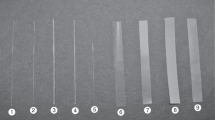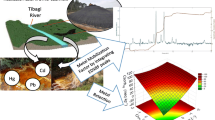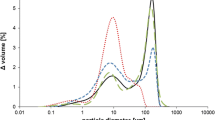Abstract
Desorption of hydrophobic organic contaminants (HOCs) from sedimentary materials plays a vital role in dictating the fate and transport of HOCs in the environment. Desorption irreversibility is a commonly observed phenomenon in laboratory sorption/desorption studies of HOCs. A desorption-resistant fraction (DRF) typically exists during the desorption process. To correctly evaluate the DRF of HOCs can considerably contribute to the understanding of availability and bioavailability of HOCs. This can substantially benefit contaminant remediation and cleanup operations. Conventional batch method to measure the DRF replies on repetitive washing of the sediments, which is time-consuming and can be impractical. This study presents an experimental protocol to quantify the DRF of the sediment-sorbed organic contaminants in a rapid manner. This protocol utilizes cosolvent to expedite desorption kinetics and adopts an ultrafiltration/centrifugation combined method to achieve a complete separation of sediment and solution phases. This proposed experimental protocol can facilitate the quantification of the DRF of sorbed contaminants to understand and minimize the uncertainties associated with risk-based pollution remediation approach. This protocol has the potential to be widely used in environmental studies to characterize sorption and desorption properties of HOCs with soil and sedimentary materials.





Similar content being viewed by others
Abbreviations
- C :
-
solution-phase contaminant concentration (μg mL−1)
- C s :
-
solution-phase contaminant concentration after each desorption step (μg mL−1)
- C sat :
-
contaminant aqueous solubility (μg mL−1)
- f :
-
fraction of \( {q}_{\mathrm{resistant}}^{\mathrm{max}} \) that is filled during sorption
- f oc :
-
organic carbon content
- F Rs :
-
solubility enhancement factor
- K oc :
-
organic carbon normalized partitioning coefficient
- K ow :
-
octanol/water partitioning coefficient
- \( {K}_{\mathrm{OC}}^{\mathrm{reversible}} \) :
-
organic carbon normalized partitioning coefficient of the reversible fraction (mL g−1)
- \( {K}_{\mathrm{oc}}^{\mathrm{resistant}} \) :
-
organic carbon normalized partitioning coefficient of the resistant fraction (mL g−1)
- M :
-
mass of sediment used in the desorption in the recommended experimental approach (g)
- q :
-
sediment-phase contaminant concentration (μg g−1)
- q 0 :
-
sediment-phase contaminant concentration at the beginning of desorption experiment (μg g−1)
- q′:
-
sediment-phase contaminant concentration at the end of the desorption experiment measured by sediment Soxhlet extraction (μg g−1)
- q initial :
-
initial sediment-phase contaminant concentration (μg g−1)
- \( {q}_{\mathrm{resistant}}^{\mathrm{max}} \) :
-
maximum capacity of desorption resistant fraction (μg g−1)
- q resistant :
-
desorption resistant fraction (μg g−1)
- q re − adsorb :
-
re-adsorbed contaminant amount (μg g−1)
- q reversible :
-
desorption reversible fraction (μg g−1)
- γ w :
-
activity coefficient of solute in water
- γ MS :
-
activity coefficient of solute in mixed solvent
- V :
-
mixed solvent volume removed in the recommended experimental approach (mL)
- V W :
-
molar volume of water
- V MS :
-
molar volumes of mixed solvent
References
Aschermann G, Zietzschmann F, Jekel M (2018) Influence of dissolved organic matter and activated carbon pore characteristics on organic micropollutant desorption. Water Res 133:123–131
Barnier C, Ouvrard S, Robin C, Morel JL (2014) Desorption kinetics of PAHs from aged industrial soils for availability assessment. Sci Total Environ 470-471:639–645
Carroll KM, Harkness MR, Bracco AA, Balcarcel RR (1994) Application of a permeant/polymer diffusional model to the desorption of polychlorinated biphenyls from Hudson River sediments. Environ Sci Technol 28:253–258
Chen W (1999) Impact of irreversible sorption on sediment quality. Ph.D. thesis, Rice University, Houston, TX
Chen W, Kan AT, Fu G, Vignona LC, Tomson MB (1999) Adsorption-desorption behaviors of hydrophobic organic compounds in sediments of Lake Charles, Louisiana, USA. Environ Toxicol Chem 18:1610–1616
Chen W, Kan AT, Tomson MB (2000) Irreversible adsorption of chlorinated benzenes to natural sediments: implications for sediment quality criteria. Environ Sci Technol 34:385–392
Chen W, Kan AT, Newell CJ, Moore E, Tomson MB (2002) More realistic soil cleanup standards with dual-equilibrium desorption. Groundwater 40:153–164
Chen C-E, Jones KC, Ying G-G, Zhang H (2014) Desorption kinetics of sulfonamide and trimethoprim antibiotics in soils assessed with diffusive gradients in thin-films. Environ Sci Technol 48:5530–5536
Chen H, Reinhard M, Nguyen VT, Gin YK (2016) Reversible and irreversible sorption of perfluorinated compounds (PFCs) by sediments of an urban reservoir. Chemosphere 144:1747–1753
Chiou CT, Kile DE (1998) Deviations from sorption linearity on soils of polar and nonpolar organic compounds at low relative concentrations. Environ Sci Technol 32:338–343
Choi H, Lawal W, Al-Abed SR (2015) Desorption, partitioning, and dechlorination characteristics of PCBs in sediments in interaction with reactive activated carbon. J Hazard Mater 287:118–125
Clark MM (2009) Transport modeling for environmental engineers and scientists, 2nd edn. Wiley
Cornelissen G, van Noort PCM, Govers HAJ (1997) Desorption kinetics of chlorobenzenes, polycyclic aromatic hydrocarbons, and polychlorinated biphenyls: sediment extraction with Tenax® and effects of contact time and solute hydrophobicity. Environ Toxicol Chem 16:1351–1357
Cristale J, Álvarez-Martín A, Rodríguez-Cruz S, Sánchez-Martín MJ, Lacorte S (2017) Sorption and desorption of organophosphate esters with different hydrophobicity by soils. Environ Sci Pollut Res 24:27870–27878
Cui X, Mayer P, Gan J (2013) Methods to assess bioavailability of hydrophobic organic contaminants: principles, operations, and limitations. Environ Pollut 172:223–234
Diaz JMC, Martin-Laurent F, Beguet J, Nogales R, Romero E (2017) Fate and effect of imidacloprid on vermicompost-amended soils under dissimilar conditions: risk for soil functions, structure, and bacterial abundance. Sci Total Environ 579:1111–1119
Ehlers LJ, Luthy RG (2003) Contaminant bioavailability in soil and sediment. Environ Sci Technol 37:295A–302A
Griffiths RA (2004) Sorption and desorption by ideal two-compartment systems: unusual behavior and data interpretation problems. Chemosphere 55:443–454
Jing F, Pan M, Chen J (2018) Kinetic and isothermal adsorption-desorption of PAEs on biochars: effect of biomass feedstock, pyrolysis temperature, and mechanism implication of desorption hysteresis. Environ Sci Pollut Res 25:11493–11504
Kan AT, Fu G, Hunter MA, Tomson MB (1997) Irreversible adsorption of naphthalene and tetrachlorobiphenyl to Lula and surrogate sediments. Environ Sci Technol 31:2176–2185
Kan AT, Fu G, Hunter M, Chen W, Ward CH, Tomson MB (1998) Irreversible sorption of neutral hydrocarbons to sediments: experimental observations and model predictions. Environ Sci Technol 32:892–902
Khan NA, Hasan Z, Jhung SH (2013) Adsorptive removal of hazardous materials using metal-organic frameworks (MOFs): a review. J Hazard Mater 244–245:444–456
Lewandowski KK, Cieślikiewicz W, Kobusińska ME, Niemirycz E (2018) Sorption of pentachlorophenol (PCP) in the marine bottom sediments—batch sorption experiment at varying pressure. Environ Sci Pollut Res 25:10799–10807
Liu J, Ma Y, Zhu D, Xia T, Qi Y, Yao Y, Guo X, Ji R, Chen W (2018) Polystyrene nanoplastics-enhanced contaminant transport: role of irreversible adsorption in glassy polymeric domain. Environ Sci Technol 52:2677–2685
Loganathan BG, Lam PK (2011) Global contamination trends of persistent organic chemicals. CRC Press
Martín J, Orta MM, Medina-Carrasco S, Santos JL, Aparicio I, Alonso E (2018) Removal of priority and emerging pollutants from aqueous media by adsorption onto synthetic organo-funtionalized high-charge swelling micas. Environ Res 164:488–494
Mayer P, Olsen JL, Gouliarmou V, Hasinger M, Kendler R, Loibner AP (2011) A contaminant trap as a tool for isolating and measuring the desorption resistant fraction of soil pollutants. Environ Sci Technol 45:2932–2937
Mayer P, Hilber I, Gouliarmou V, Hale SE, Cornelissen G, Bucheli TD (2016) How to determine the environmental exposure of PAHs originating from biochar. Environ Sci Technol 50:1941–1948
Nzengung VA, Voudrias EA, Nkedi-Kizza P, Wampler JM, Weaver CE (1995) Organic cosolvent effects on sorption equilibrium of hydrophobic organic chemicals by organoclays. Environ Sci Technol 30:89–96
Nzengung VA, Nkedi-Kizza P, Jessup RE, Voudrias EA (1997) Organic cosolvent effects on sorption kinetics of hydrophobic organic chemicals by organoclays. Environ Sci Technol 31:1470–1475
de Oliveira Neto OF, Arenas AY, Fostier AH (2017) Sorption of thiabendazole in sub-tropical Brazilian soils. Environ Sci Pollut Res 24:16503–16512
Pan G, Jia C, Zhao D, You C, Chen H, Jiang G (2009) Effect of cationic and anionic surfactants on the sorption and desorption of perfluorooctane sulfonate (PFOS) on natural sediments. Environ Pollut 157:325–330
Qi Z, Hou L, Zhu D, Ji R, Chen W (2014) Enhanced transport of phenanthrene and 1-naphthol by colloidal graphene oxide nanoparticles in saturated soil. Environ Sci Technol 48:10136–10144
Salloum MJ, Chefetz B, Hatcher PG (2002) Phenanthrene sorption by aliphatic-rich natural organic matter. Environ Sci Technol 36:1953–1958
Sander M, Pignatello JJ (2009) Sorption irreversibility of 1,4-dichlorobenzene in two natural organic matter–rich geosorbents. Environ Toxicol Chem 28:447–457
Sander M, Lu YF, Pignatello JJ (2005) A thermodynamically based method to quantify true sorption hysteresis. J Environ Qual 34:1063–1072
Sandler SI (2017) Chemical, biochemical, and engineering thermodynamics, 5th edn. Wiley
Schnoor JL (1996) Environmental modeling: Fate and transport of pollutants in water, air, and soil. Wiley-Interscience
Schwarzenbach RP, Gschwend P.M, Imboden D.M (2013) Environmental organic chemistry, 3rd edn. Wiley
Semple KT, Riding MJ, McAllister JE, Sopena-Vazquez F, Bending GD (2013) Impact of black carbon on the bioaccessibility of organic contaminants in soil. J Hazard Mater 261:808–816
Spasojević JM, Maletić SP, Rončević SD, Radnović DV, Čučak DI, Tričković JS, Dalmacija BD (2015) Using chemical desorption of PAHs from sediment to model biodegradation during bioavailability assessment. J Hazard Mater 283:60–69
U.S. Environmental Protection Agency (EPA) (1998) Contaminated sediment management strategy (EPA-823-R-98-001). Office of Water, Washington, DC
Umeh AC, Duan L, Naidu R, Semple KT (2017) Residual hydrophobic organic contaminants in soil: are they a barrier to risk-based approaches for managing contaminated land? Environ Int 98:18–34
Xing B, Pignatello JJ (1998) Competitive sorption between 1,3-dichlorobenzene or 2,4-dichlorophenol and natural aromatic acids in soil organic matter. Environ Sci Technol 32:614–619
Yang K, Xing B (2010) Adsorption of organic compounds by carbon nanomaterials in aqueous phase: Polanyi theory and its application. Chem Rev 110:5989–6008
Zhang L, Wang L, Zhang P, Kan AT, Chen W, Tomson MB (2011) Facilitated transport of 2,2,5,5-polychlorinated biphenyl and phenanthrene by fullerene nanoparticles through sandy soil columns. Environ Sci Technol 45:1341–1348
Zhu B, Xia X, Wu S, Lu X, Yin X (2016) Microbial bioavailability of 2,2′,4,4’-Tetrabromodiphenyl ether (BDE-47) in natural sediments from major rivers of China. Chemosphere 153:386–393
Funding
The authors appreciate the sponsorship of Science and Technology Development Fund, Macao S.A.R (FDCT) (0063/2018/A2) and Start-Up Research Grant provided by the University of Macau (SRG2018-00112-FST). This work was also financially supported by Brine Chemistry Consortium companies of Rice University, including Aegis, Apache, BHGE, BWA, Chevron, ConocoPhillips, Coastal Chemical, EOG Resources, ExxonMobil, Flotek Industries, Halliburton, Hess, Italmatch, JACAM, Kemira, Kinder Morgan, Nalco, Oasis, Occidental Oil and Gas, Range Resources, RSI, Saudi Aramco, Schlumberger, Shell, SNF, Statoil, Suez, Total, and the NSF Nanosystems Engineering Research Center for Nanotechnology-Enabled Water Treatment (ERC-1449500).
Author information
Authors and Affiliations
Corresponding author
Ethics declarations
Conflict of interest
The authors declare that they have no conflict of interest.
Additional information
Responsible editor: Zhihong Xu
Publisher’s note
Springer Nature remains neutral with regard to jurisdictional claims in published maps and institutional affiliations.
Electronic supplementary material
ESM 1
(DOCX 76 kb)
Rights and permissions
About this article
Cite this article
Zhang, P., Huang, S., Kan, A.T. et al. A rapid experimental protocol to determine the desorption resistant fraction of sediment-sorbed hydrophobic organic contaminants. Environ Sci Pollut Res 27, 1449–1460 (2020). https://doi.org/10.1007/s11356-019-06521-z
Received:
Accepted:
Published:
Issue Date:
DOI: https://doi.org/10.1007/s11356-019-06521-z




